Hexagons are ubiquitous in wargames now (indeed, both Philip Sabin’s War: Studying Conflict Through Simulation Games and Peter Perla’s The Art of Wargaming feature hexagons on their book covers), but this wasn’t always the case. My first wargame – the first board wargame for many of us – was Avalon Hill’s original Gettysburg (by the way, $75 seems to be the going price for a copy on eBay these days).
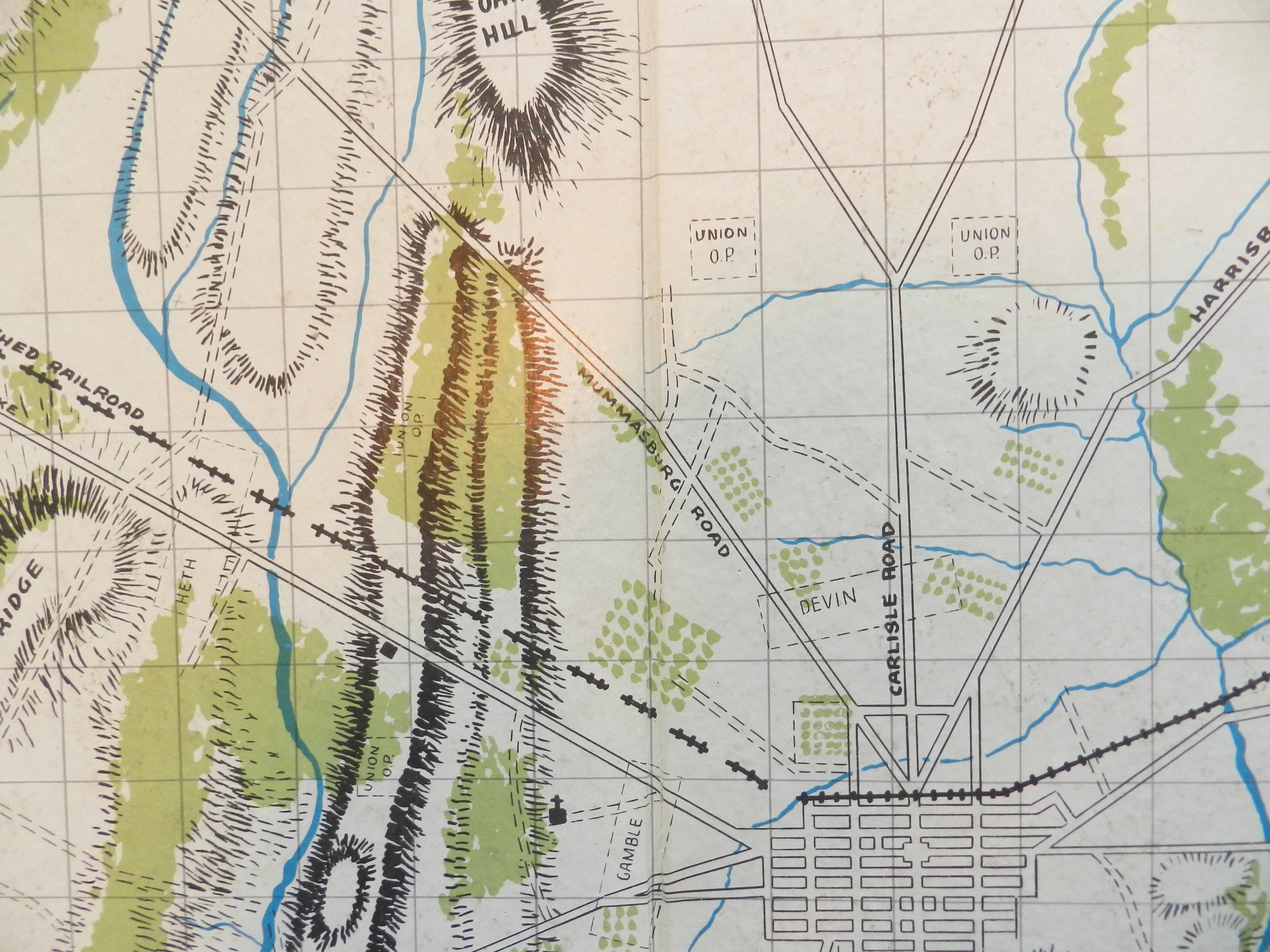
No hexagons in Avalon Hill’s original Gettysburg. Remember how the map contained the original starting positions for the Union cavalry and out posts? From author’s collection. (Click to enlarge)
The American Kriegsspiel by Captain Livermore (circa 1882) only had a map grid for estimating distances. We also have a map grid in General Staff to facilitate estimating distances but you can turn the map grid on or off.
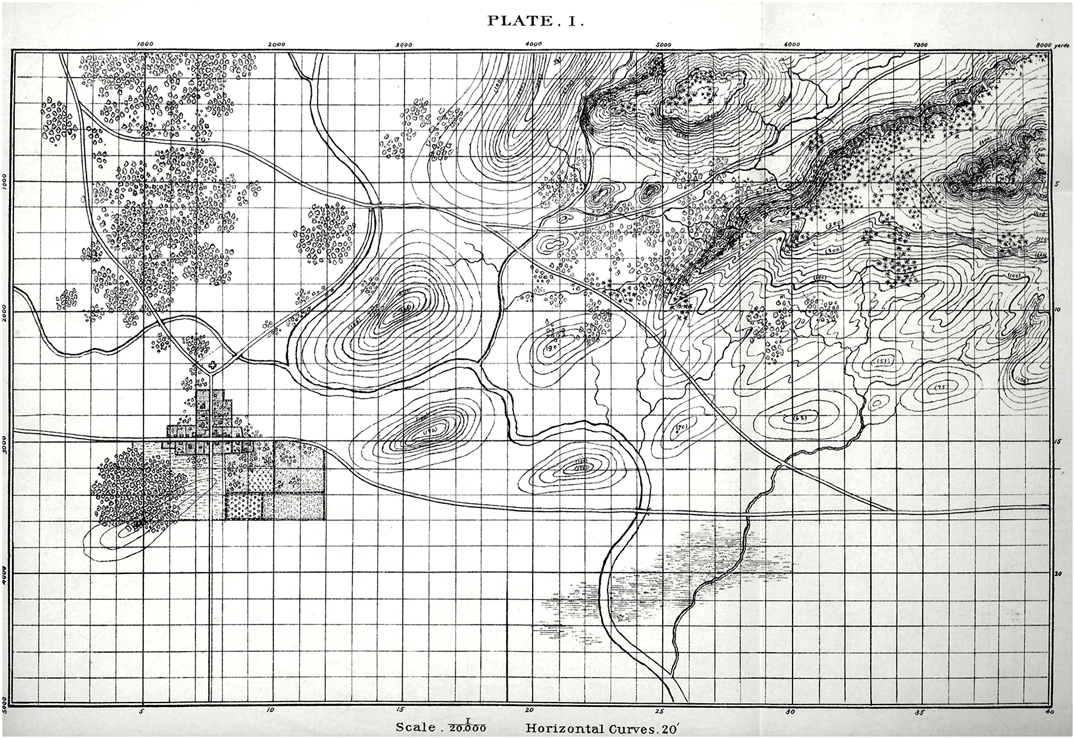
Plate 1 from The American Kriegsspiel by Captain Livermore. Click to enlarge. This image is from GrogHeads wonderful blog post on Nineteenth Century Military War Games. Link: http://grogheads.com/featured-posts/5321
And how about this picture from the Naval War College (circa 1940s)? I just needed an excuse to post this photograph:
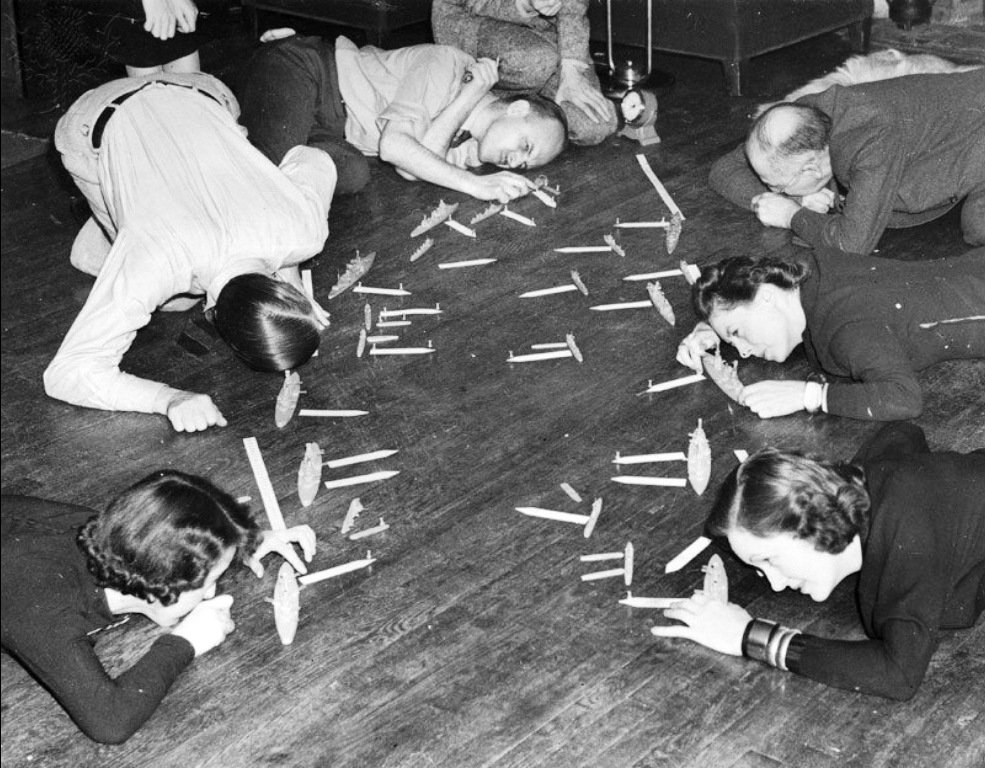
A Fletcher Pratt Naval War Game in progress. I never understood why they didn’t use upside down periscopes to check broadside angles rather than getting down on the floor. Click to enlarge. From this blog http://wargamingmiscellany.blogspot.com/2016/02/simulating-gunfire-in-naval-wargames.html
It is pretty common knowledge among the wargaming community that Avalon Hill’s owner, Charles Roberts, introduced hexagons to commercial wargaming in the early 1950s .
“Later, he [Roberts] saw a photograph of one of the RAND gaming facilities and noted they were using an hexagonal grid. This grid allowed movement between adjacent hexagons (or hexes, as they are more frequently called) to be equidistant, whereas movement along the diagonals in a square grid covered more distance than movement across the sides of the squares. Roberts immediately saw the usefulness of this technique and adopted to his subsequent games.”
– The Art of Wargaming, Perla, p. 116
In researching how the RAND Corporation – a major post-war defense think tank – came up with the original idea of employing hexagons to simplify movement calculations (as well as the invention of the Combat Resolution Table or CRT) I stumbled upon an amazing document: Some War Games by John Nash and R. M. Thrall (Project RAND, 10 September 1952; available as a free download here). Yes, that is THE John Nash; A Beautiful Mind John Nash; the Nobel Prize recipient John Nash. The Some War Games summary states:
“These games are descendants of the one originally instigated by A. Mood, and are both played on his hexagonal-honey comb-pattern board. – Some War Games Nash & Thrall.
But what appears on Page 1A of Some War Games is even more exciting:
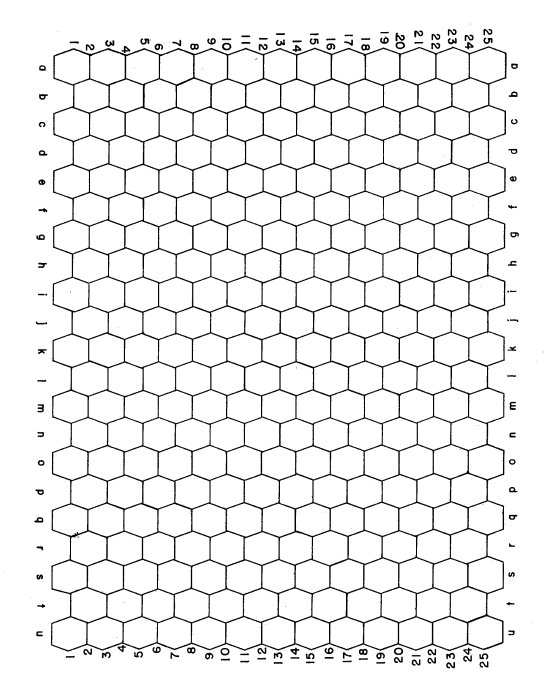
The earliest reference of using hexagons for wargames. “The board is a honeycomb pattern of hexagonal “squares,” the same that was used in Mood’s game” – From Some War Games (Project RAND, Nash & Thrall).
Sadly, I have been unable to find an actual copy or documentation for “Mood’s game,” but did discover that A. Mood was a statistician who wrote the popular text book, “Introduction to the Theory of Statistics,” and, during World War II was involved with the Applied Mathematics Panel and the Statistical Research Group. Mood was also the author of, “War Gaming as a Technique of Analysis,” September 3, 1954 which is available as a free download here. Unfortunately, I have yet to uncover any images of Mood’s original war game and the very first use of his ‘honeycomb pattern’ board.
Let’s take a quick look at the math behind hexagons:
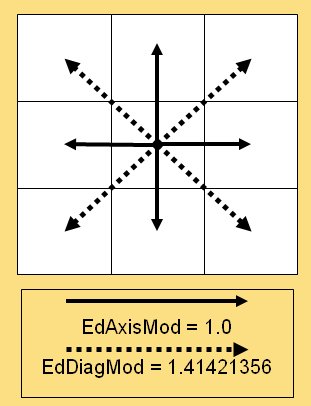
The cost of moving diagonally as opposed to horizontally or vertically on a map board (from a slide in my PhD Qualifying Exam on least weighted path algorithms).
The problem of quick and easy movement calculation (as shown in the above graphic) is caused by the Pythagorean Theorem. Well, not so much caused, as a result of the theorem:
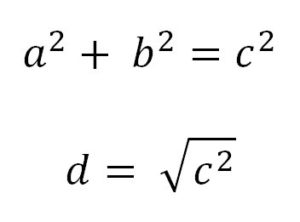
The distance to a diagonal square, d, is the square root of the square of the hypotenuse (the side opposite the right angle) which is equal to the sum of the squares of the other two sides. We all learned this watching the Scarecrow in the Wizard of Oz, right?
In other words, if everybody could just multiply by 1.41421356 in their heads we wouldn’t even need hexagons! The downside, of course, is now we’ve restricted our original eight axes of movement to six. And there’s another problem; what I call the, “drunken hexagon walk.”
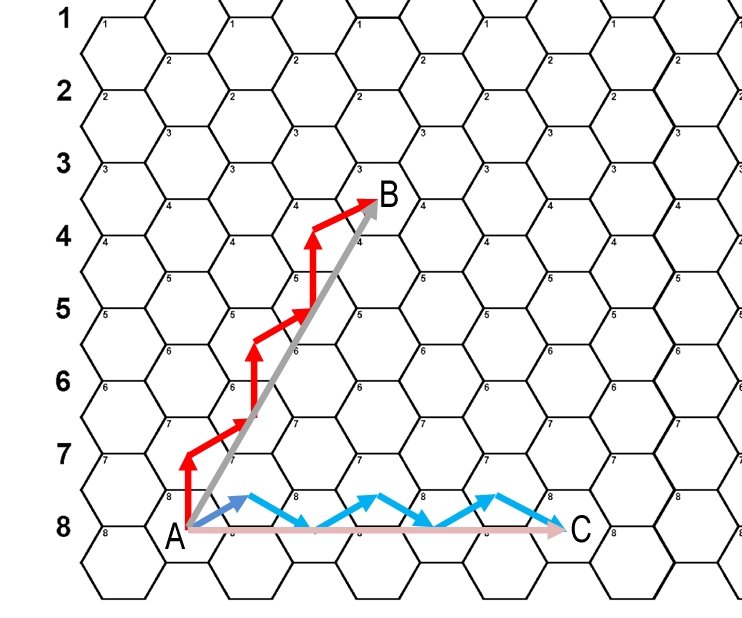
An example of “drunken hexagon walk” syndrome. All we’re trying to do is go in a straight line from Point A to Point B and from Point A to Point C.
In the above diagram we just want to travel in a straight line from Point A to Point B. It’s a thirty degree angle. What could be simpler? How about traveling from Point A to Point C? It’s a straight 90 degree angle. It’s one of the cardinal degrees! What could be simpler than that? Instead our units are twisting and turning first left, then right, then left like a drunk stumbling from one light post to another light post across the street. In theory the units are actually traversing considerably more terrain than they would if they could simply travel in a straight line. This is the downfall of the hex: sometimes it simplifies movement; but just as often it creates absurd movement paths that no actual military unit would ever take.
So, what’s the solution? Clearly, there is no reason why a computer wargame should employ hexes. Computers are very good at multiplying by 1.41421356 or any other number for that matter. Below is a screen shot of General Staff:
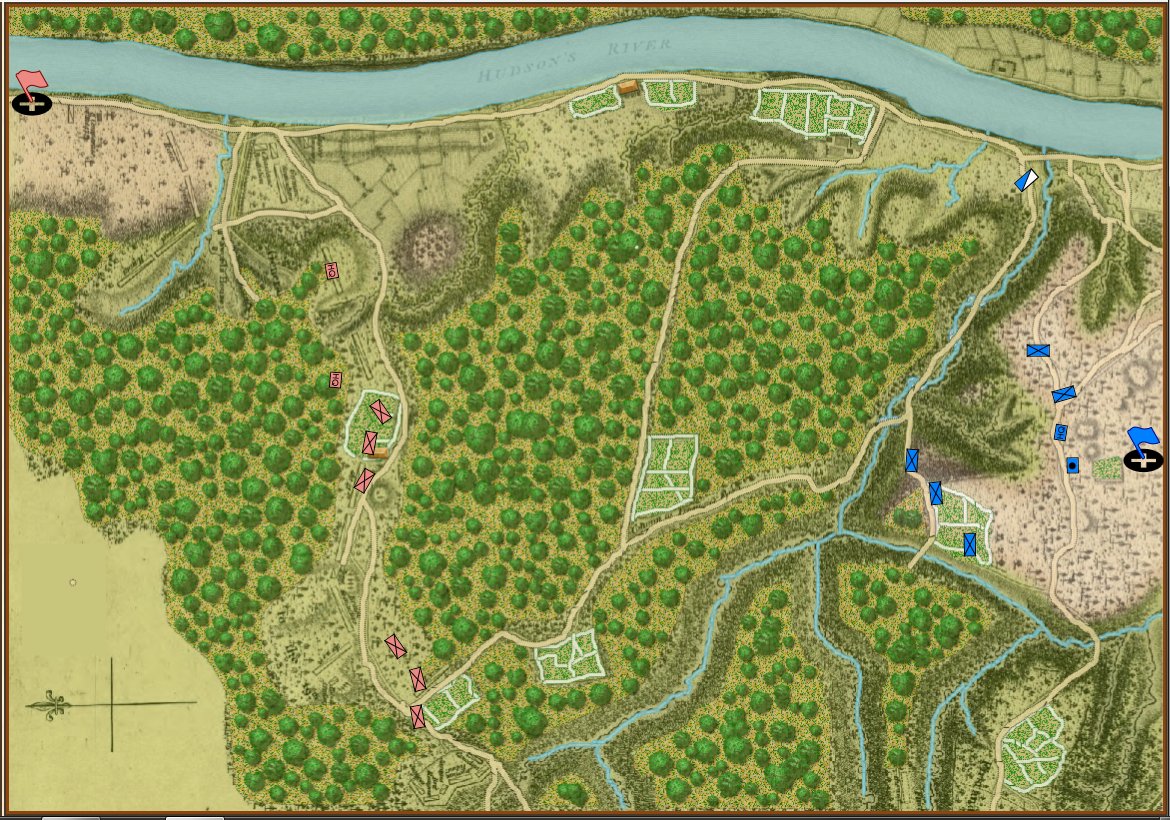
Screen shot of General Staff (2nd Saratoga) based on the map of Lt. Wilkinson, “showing the positions of His Excellency General Burgoyne’s Army at Saratoga published in London 1780) . Click to enlarge.
What’s missing from the General Staff screen shot, above? Well, hexes, obviously. Units move wherever you tell them to in straight lines or following roads precisely if so ordered. And units can obviously face in 360 degrees. Consider this screen shot from the General Staff Sandbox where we’re testing our combat calculations:

Screen shot from the General Staff Sandbox. Notes: 3D unit visibility is turned on, displayed values: unit facing, distance, target bearing, enfilade values, target offset. Click to enlarge.
For board wargames hexagons seem to be a necessary evil unless you want to break out the rulers (that never stopped us with the original Gettysburg or Jutland). But, when it comes to computer wargames, I just don’t see the upside for hexagons but I do see a lot of downside. And that’s why General Staff doesn’t use hexes.

If you run into a problem that is too much for a PhD, time to find a community college dropout whose sole interest is programming.
I didn’t have much college when I wrote UMS, UMS II, War College, Designasaurus, Jack the Ripper, MOG93, etc. When you get in to grad school for computer science it’s not so much coding as research, algorithms and a lot of math.
Interesting discussion but I feel many gamers like hexes due to the lack of subjectivity in movement, etc. Rulers can be “stretched” as many gamers do, but that can’t be done with hexes. On the other hand, hexes (on the map) make it too easy to pre estimate movement, range, etc hence taking away from the simulation aspect of distance estimation as was done in earlier warfare. Some games like X-Wing use templates for movement and range to get away from hexes. I assume your game (being a computer game) will not use “stretched” rulers 🙂 and look forward to it!
P.S. the Rand people are often clueless when it comes to actual war. Hence Vietnam. The self-styled “best and brightest” should have stayed at some university and published their papers for other academics, and left war planning to the real experts. Of course hex movement is silly and Reisswitz had the correct approach. But in the practical world hex rules, including in current use in the military. By the way, did you consider at all the vital role of the umpire in Kriegspiel? Think about it, assuming you read the book. Just how would one implement the umpire in code? Not so easy, right? It only takes about 5 minutes (or 1 minute if on coffee) to figure that out. 🙂
The biggest problem with the way that the military uses wargames is, to quote a friend, “they use wargames like drunks use streetlights. Not for illumination, but for support.”
I also work on military sims. Sorry I can’t say where. I considered abandoning hexes in my own programming, after reading the rules for the original Kriegspiel by Reisswitz. After thinking for about 5 minutes (no coffee yet or it would have been 1 minute) I realized abandoning the constraint imposed by hexes would result in unacceptably higher complexity in the AI. And I don’t even have a PhD! Frankly who needs one, because the algorithms are actually quite simple. I think none of the best programmers spend much time chasing degrees, and in fact some of the very best either drop out of college or never go in the first place. I’m guessing that the reason your game is taking so long may have something to do with running into issues with the AI you can’t solve, because the overall design is flawed. Sorry I can’t give my real email, and perhaps you won’t post my reply without it, but it would be interesting to see your reply.
The delays in General Staff have nothing to do with the AI. It is because it is unique in providing a complete suite of wargame tools for creating OOBs, maps, and scenarios with the designer having complete control over all aspects of the simulation. This is basically on the level of the Army’s OneSAF (which had a budget of $1.4 billion). In the past, my wargames were funded by publishers who put up the money and took 85% of the gross. We’re self funded. Consequently, I don’t have a staff like I used to. It’s just Andy and me (plus some friends volunteering to help with the artwork).
Thank you for the historical information. I think there are two places where “Mood” has been replaced with “Moore” as a name. All the best.
Fixed. Thanks!
Pingback: Wargame AI Continued: Range of Influence | General Staff
I’m not sure what point you are trying to make with this article. You first start talking about older war games from last century some time. Nice old picture of what people playing Games Workshop games do. You reference some papers/books published in the 1950’s, then you jump to the 21’st century and say computer games shouldn’t use hexes because computers can do the math easily. You’re basically saying technology today can do better than technology last century which is like a “captain obvious” moment.
Where are you going with this? Is there some modern computer game that is not a straight computer port of an old game from last century? The few computer games I have seen that used a grid is actually a straight port of a boardgame. Those boardgames have to use some type of grid because well, it’s a boardgame. I’ve seen computer games that is based on a tabletop game that takes advantage of computing power to make it a computer game while retaining the flavour of the baordgame it is based off of.
When playing a boardgame, it is inconvenient to do the math. You can use a ruler, but I personally feel there are issues with that as well. I prefer hex grids or any type of grid when playing a boardgame not on a computer. You use a grid or ruler/compass.
You write, “Is there some modern computer game that is not a straight computer port of an old game from last century?” Well, yes, General Staff is not a port from an old boardgame; it’s a completely new wargaming system. Please feel free to read some of my older articles and you can see lots of screen shots of General Staff under development.
I would guess Mood’s game refers to the game we usually call Hex.
https://en.wikipedia.org/wiki/Hex_(board_game)
SSG from Australia had games for the C-64 – Carriers at War, Europe Ablaze, Battlefront and an American Civil War series that you could turn the hexes and non-sighted enemy units off. The hexes were a great way of estimating range including time to contact.
Ian Trout and Roger Keating were the designer/programmers.
Yes, of course.
While I agree with you in general about hexagons and am excited that your game doesn’t use them, I’m curious if you can give a little bit more information about how you implemented movement and behavior efficiently without them. When a unit is following a move order for example, how does it generate an optimal path?
I did my doctoral ‘comprehensive exam’ (AKA ‘comps’) on Least Weighted Optimal Paths so this is a topic that I would gladly babble about for HOURS!. Here’s a link to a paper that I wrote: http://riverviewai.com/papers/JonssonAnalysis4.pdf
There’s also a big PowerPoint stack if you’re interested. I would also be glad to answer any questions.
Wll, you can do with little overhead also with hexes. In OSG operational games units moving by road cannot stack, cannot enter occupied hexes, and have a a tail. It is quite simply to play with . Other games were corps are represented by multiple units represent this visually. A lot depend on your stacking rules, scale (all this depend on how big the grid cell is compared to unit size), and unit granularity. Very little to do with hexes.
I’m not certain the problems with hexagons is the lack of movement in straight lines – to me it’s more the fact that units do no sit neatly in their hexagons. For instance, when moving, one Napoleonic corps would be strung out on kilometers of road, generating traffic jams , delays when concentrating for battle, problems when foraging, etc. This is well represented (but tedious to run) in an umpired paper game like Flight of the Eagle, but the computer could handle that automatically.
I do not think wargamers are obsessed with hexes, just that some of the attempts to avoid hexes end up with their own problems when they are not innovation for innovation sake. Said that I have no problem with areas, point to point or even card maps like in field of fire, as long they work. I also never found the ‘drunk walk’ so disturbing or detracting from the effectiveness of a simulation model. It is an abstraction of military significant movement anyway. Likewise limiting facing is an abstraction, and the main issue is its effectiveness at the level of detail retained by the simulation.
Hexes tend to produce more finely grained terrain grid than squares (the Gettysburg’s square grid strikes me as an example on how to not grid a wargame map!). Having no grid (like in miniatures) seems a solution but introduce other issues (measuring, terrain representation, accidental and non accidental movement of units…). One thing I dislike of miniature games is the lack of a grid.
In computer games I am open. Certainly having the computer taking care of a lot of things made dispensing with the grid easier. On the other hand sometime even there a grid is useful. Hexes could be an useful abstraction in some, a bit redundant in others. Again depend on the level of abstraction and, as Peter says (BTW hello Peter, I think you still remember me 🙂 ) the capabilities of the algorithm. Simply saying that there is no reason to have hexes in computer simulations is like shouting from a soap box in Hyde Park. A lot depend on what is being simulated, how, and to what purpose. Combat Mission or Command Modern Naval and Air Operations with hexes would me at least silly, but JTS Squad Battles work fine and using hexes does not make its model less effective for what it does. Again depends on the game.
Ah, what is the status of this game? When will be finished?
The General Staff Wargaming System is made up of four modules. The Army Editor (already passed beta test), the Map Editor (currently in beta test), the Scenario Editor (next up for beta test) and the wargame, itself. We hope to have everything available by Q1 or Q2 of ’19.
I do not for the love of god get your point?
My point is that there is no reason to use hexagons in a computer simulation / wargame. Hexagons create an artificial problem and restrict movement and unit facing. In a computer simulation / wargame units should be able to move and face in all 360 degrees.
Well, Naval units love to talk about direction in 12 Oh Clock. Try to tell the twelve directions with hexagon is not possible without talking about the diagonal issue. The hexagon diagonals have more distortion for distances beyond 6 hexes versus square system that use a cost of 1.5 for diagonals.
Hi Ezra
Right you are about the distortions if range—not only movement—introduced by the hex grid. I have proposed a simpler solution for using squares if you are not willing to use a measurement stick. Simply count an orthogonal move as 2 and a diagonal move as 3. There is still that 0.086 distortion (1.414 vs 1.5) but that isn’t much. At least that works for movement. Ranged fire is still a bit of an issue but as long as ranges are short it shouldn’t be that big a deal. Of course, most board wargamers are almost obsessed with hexes and not using them becomes a major hurdle to sales. On the other hand, I wonder about the very simplicity of computer algorithms. Moving a body of troops in a straight line over mixed terrain is not as easy as measuring the distance on a map. It seems to be a case of “choose your abstraction.”
Peter
Fletcher Pratt and Inga Pratt, not Fletcher and Pratt.
Fletcher Pratt is probably best known now for The Incomplete Enchanter and The Castle of Iron, with L. Sprague De Camp.
I take it from the sandbox screenshot that units will have facing and formations (line, square, etc.)?
That is 100% correct.
1. The drunken hex walk is no big deal. It\s a far more regular radius of movement than squares, and as far as computer games being able to computatively discard using grids for movement – no thanks and that\s no big deal either. Manual games are in many ways far preferable to computer games in terms of graphic perception, transparency and therewith educational value, and interpersonal playabililty/enjoyability.
2. That is Fletcher and Inga Pratt down on the floor of their apartment with friends – NOT the Naval War College. 🙂
Thanks for the information about Fletcher and Pratt. Many years ago the Naval War College had sent me a number of photos of wargames at Luce Hall and I combined these with this image. Thanks for straightening me out.
Computer wargames have many advantages over board wargames; but we haven’t yet seen what they are capable of. Line of sight, hidden movement, simultaneous combat resolution and human level AI are all possible.
In the applications I use, hexagons are more about the abstraction of low level tactical details when playing at more operational levels, than a movement abstraction. In modern combat – particularly in the maritime domain – where weapons have considerable range and the “hider vs finder” competition is of paramount importance, the hexagon lets me encapsulate the EFFECT of superior or inferior tactics for weapon employment, search and evasion, and deception and countermeasures, without requiring modeling movements and activities of units in detail. I call it the “Las Vegas Effect” – what happens inside the hex, stays inside the hex and I don’t need to ask questions! The relatively minor hit on movement is more than made up for by the ability to simplify the representation of tactical procedures and concepts of operation that often open up an “arguments phase” about how the players little cardboard “competent subordinates” would do something the rules didn’t cover, or exploit a loophole in rule wording to do something ridiculous in the real world for a benefit from a game-ism.
I agree wholeheartedly with Lou about the superiority of manual games in many ways, but with frequent time constraints in a professional setting, I’ve found it useful to use computer versions of a board game to speed adjudication. John Tiller helped with a prototype “proof of concept” for such that is available in the Google and Apple Play stores if you search on “Fleet Battle School John Tiller” .Unfortunately we never got funding to complete the effort to a “full game”. Even with the time savings, the loss of rich discussion about that very adjudication is lost – often the greatest benefit coming out of such games – when adjudication is automated. Hexes let us set the boundaries on that discussion to get at the objectives of the game and fulfill its purpose!
You’ve brought up a number of topics that are rich areas of discussion; not the least of which was, “unfortunately, we never got funding.” I just don’t understand this. One of the main reasons that I got a doctorate in computer science was because I was constantly being told by professionals in the wargaming community that with a PhD I would be a PI (Principal Investigator) and have more funding than I would know what to do with. It was great for a few years and then around 2012 DARPA, Army, Marines, DoD, et. al., suddenly had no interest in not just wargaming but C4I decision support in general. I’ve never got a straight answer for the reason why, either.
What happened in 2011-12? Seacastration. (Politicians spelled it ‘sequestration’. And in January, we’ll be right back there again.)
I remember this all too well. That’s when DARPA cut funding for C4I AI research.
Hypothesis: machine learning ate your budget.
I don’t know… of course I did my doctoral research in machine learning but DARPA isn’t funding that, either, these days. DARPA is into robots at the moment.
The drunken hexagon walk subjects to more distortion than 1.5 cost with square diagonal movement (3:2 ratio) or the 1.4 cost for diagonal movement (7:5 ratio). The 1.4 cost is best when there is no consecutive sequence of 6 tiles with the same movement cost; difficult terrain has higher movement costs.